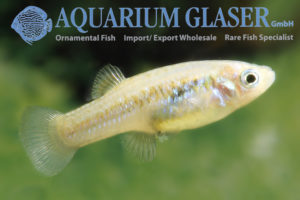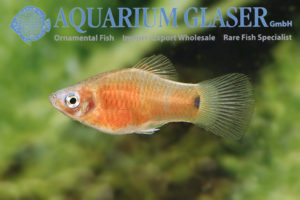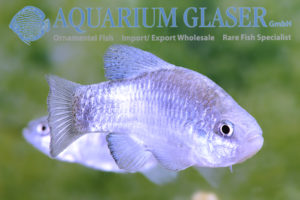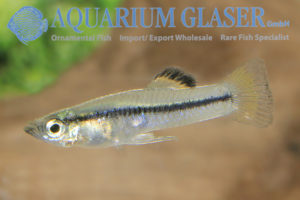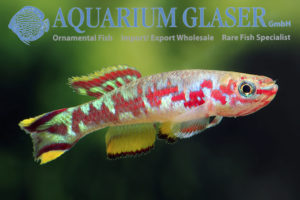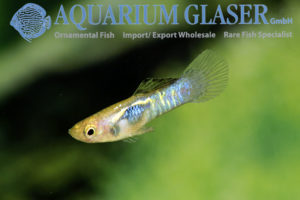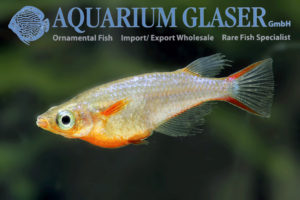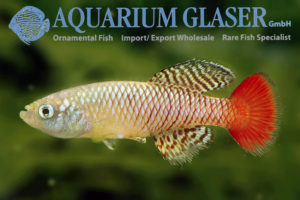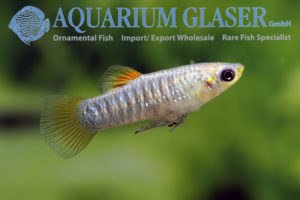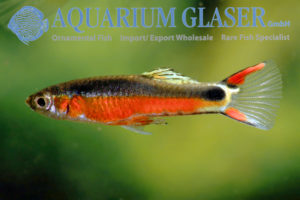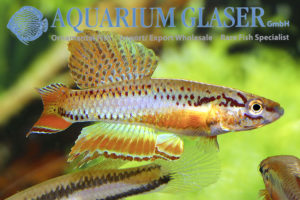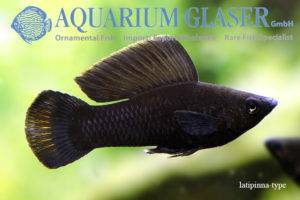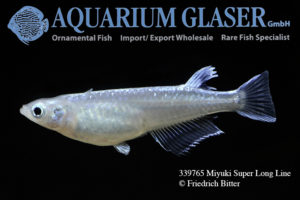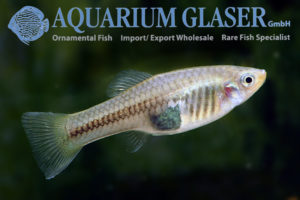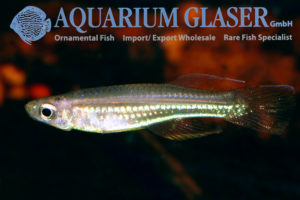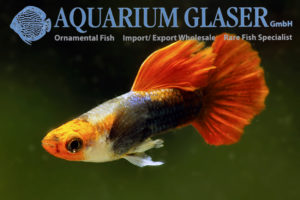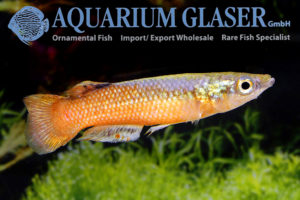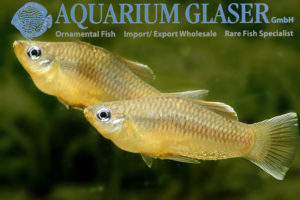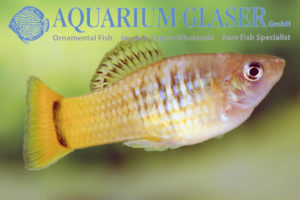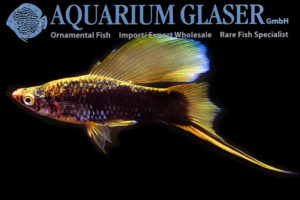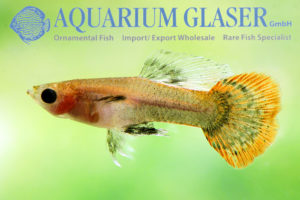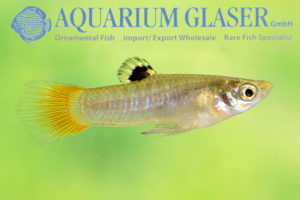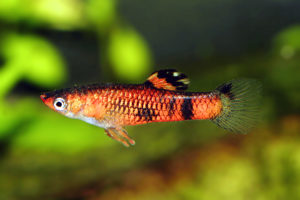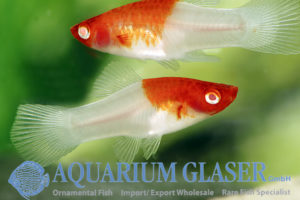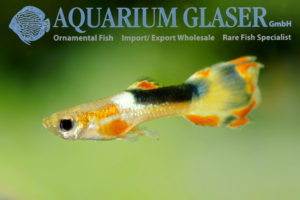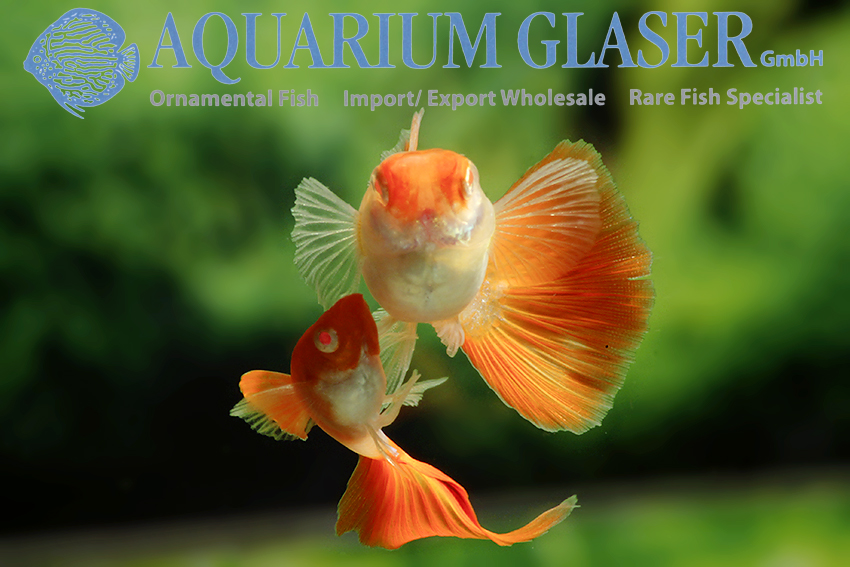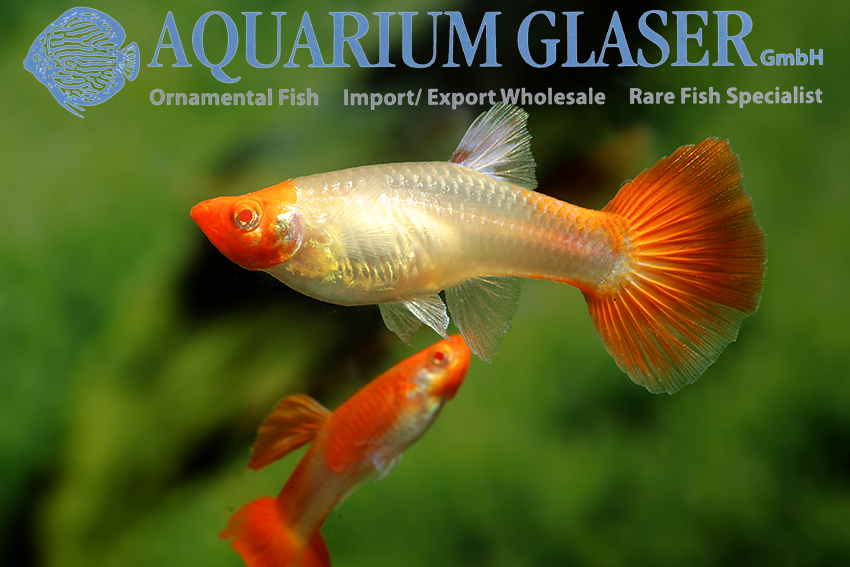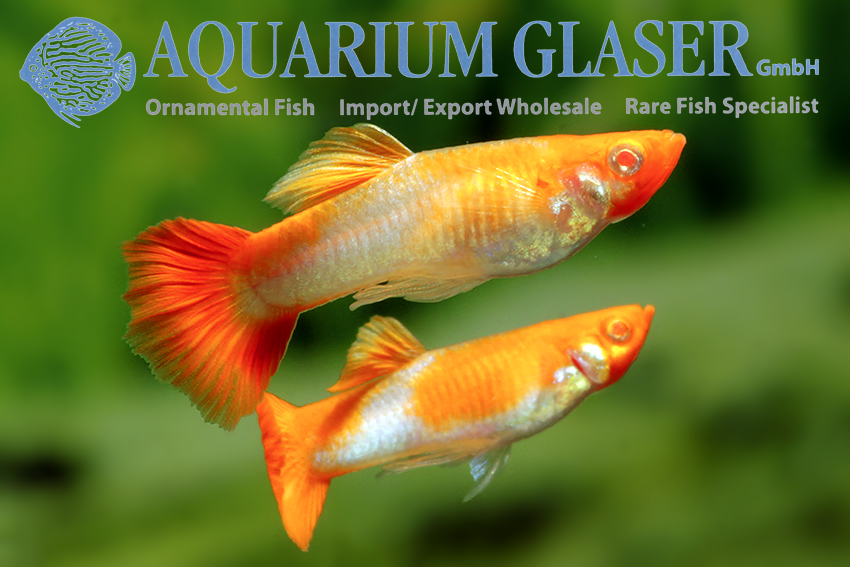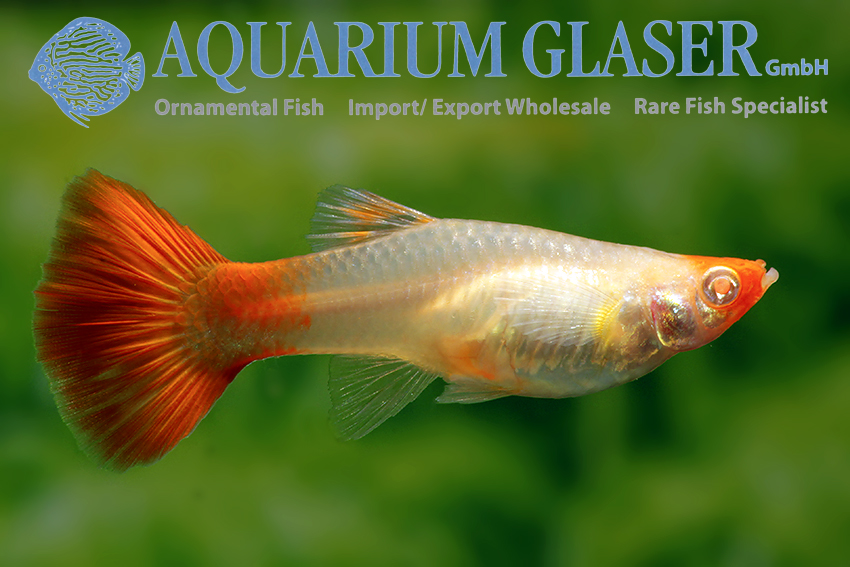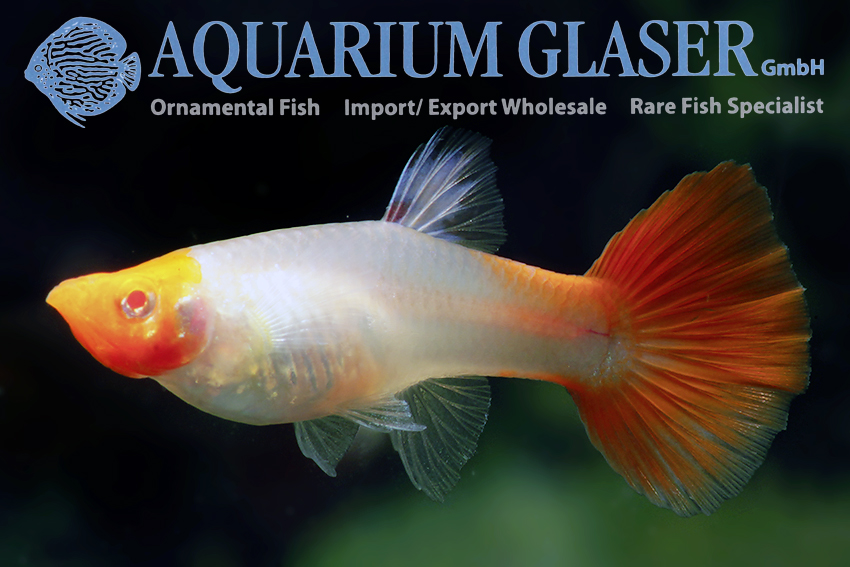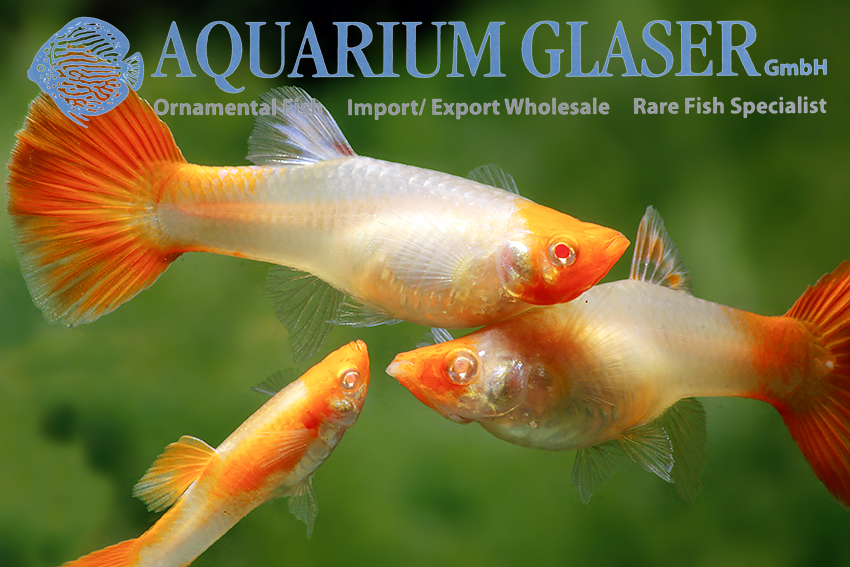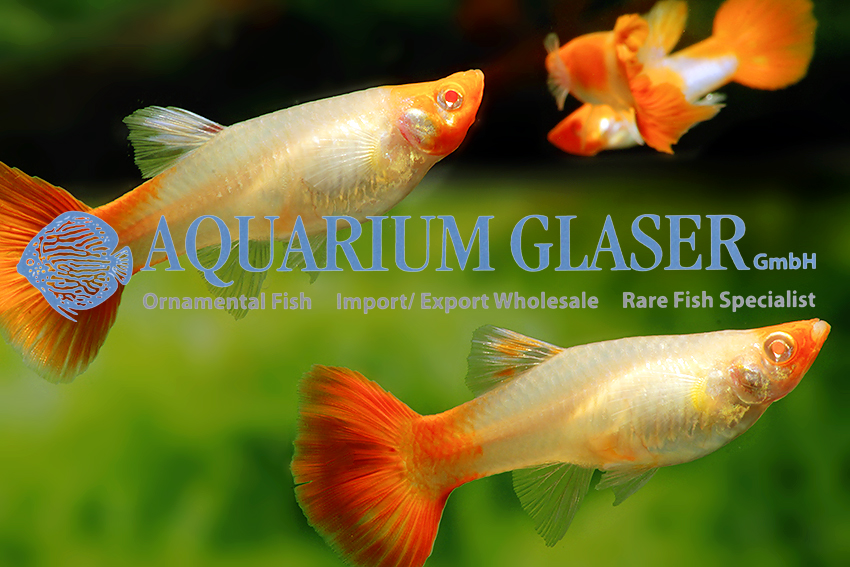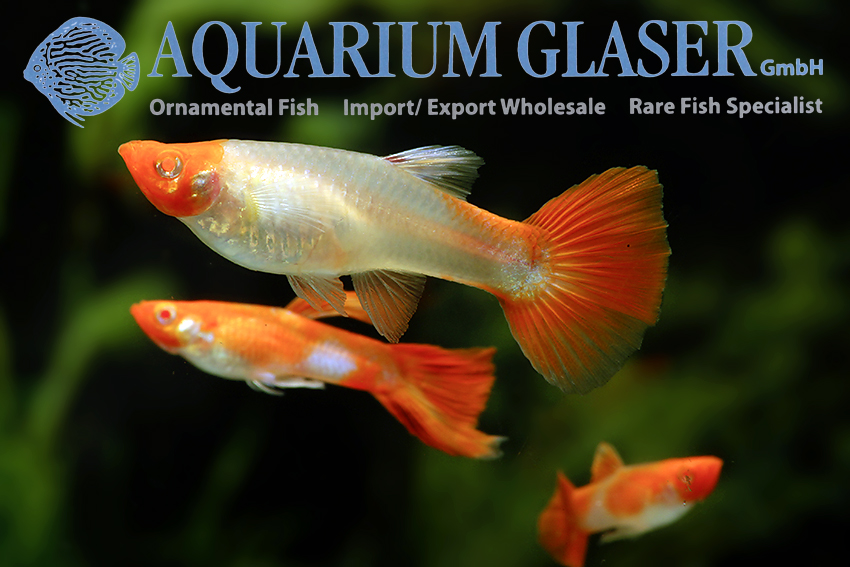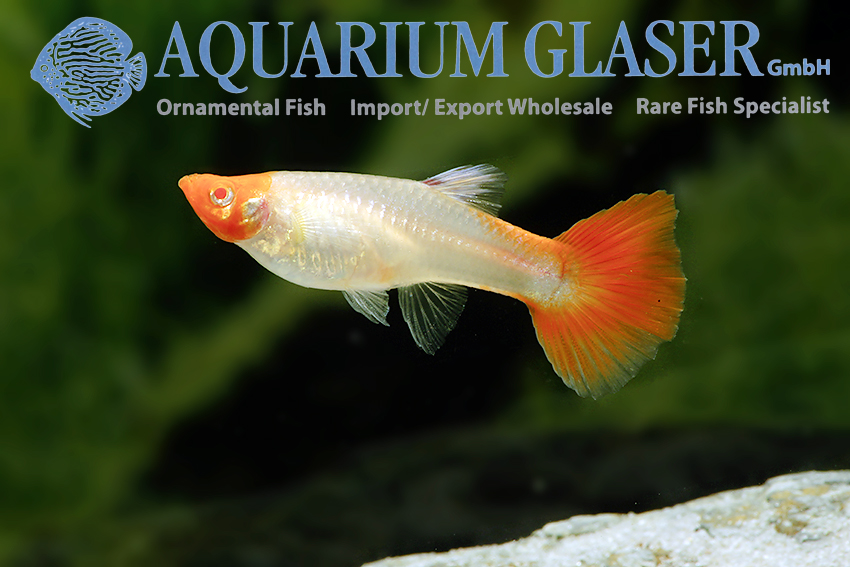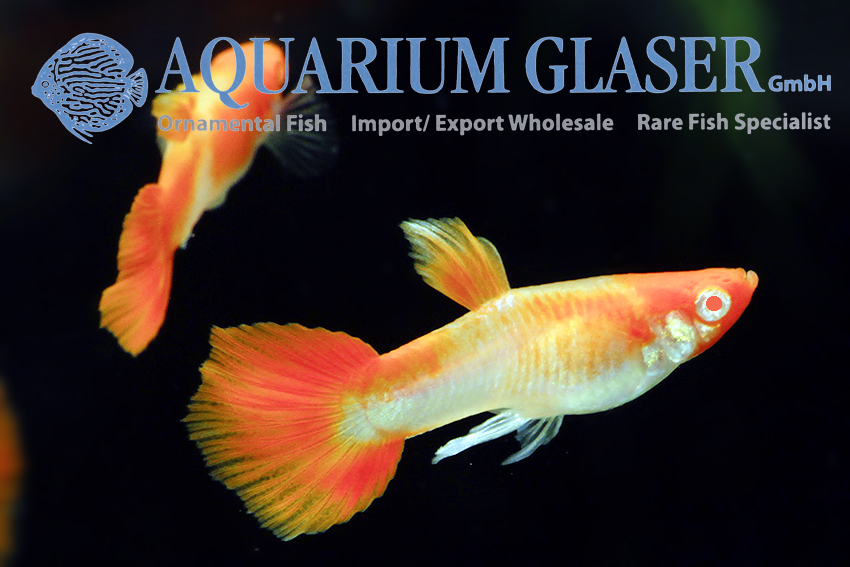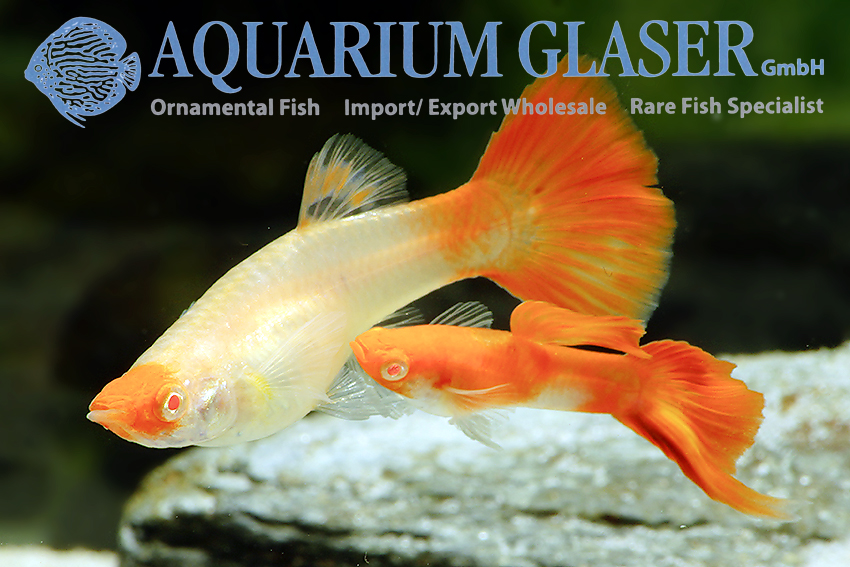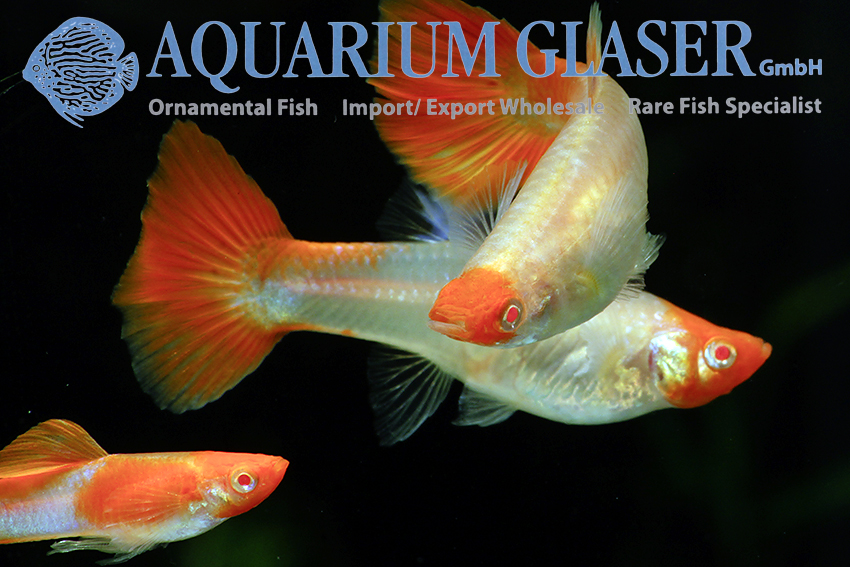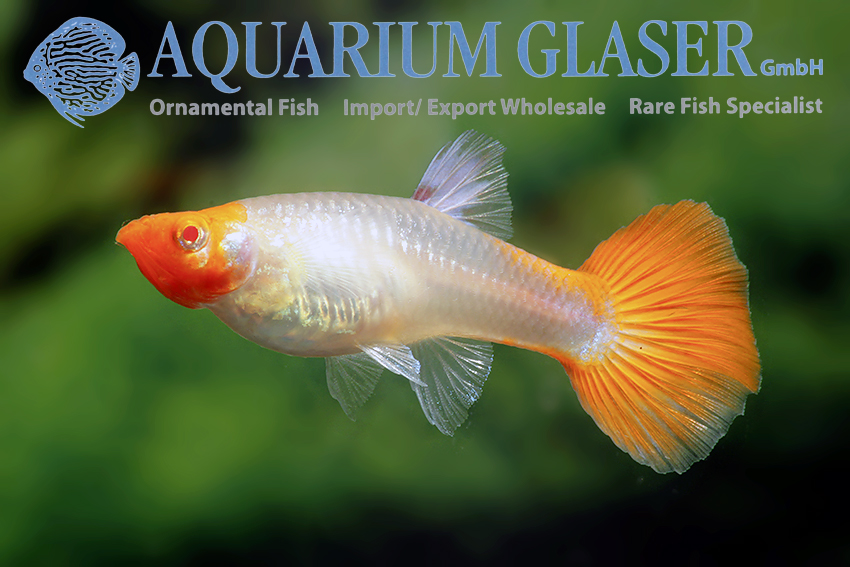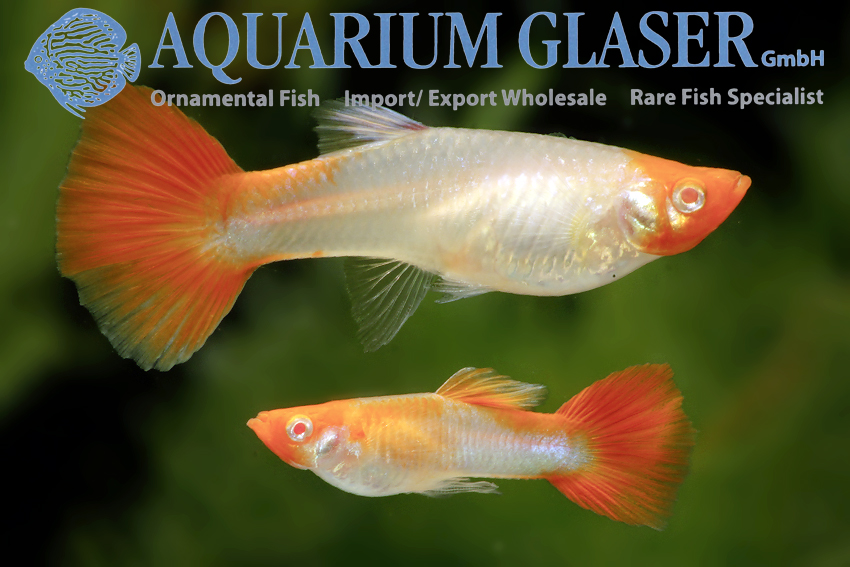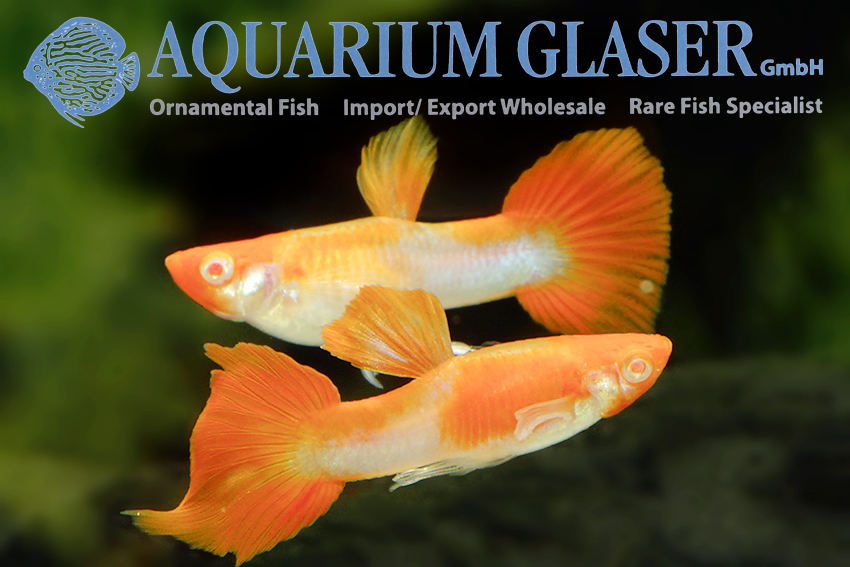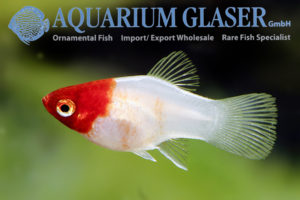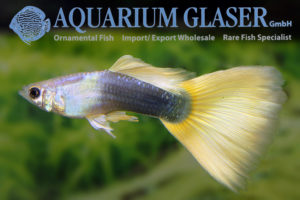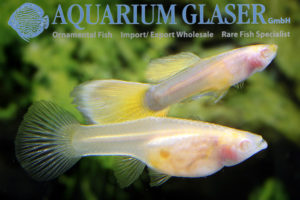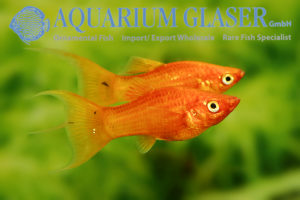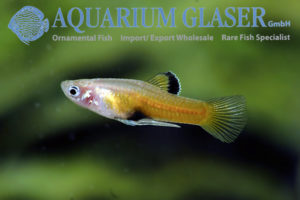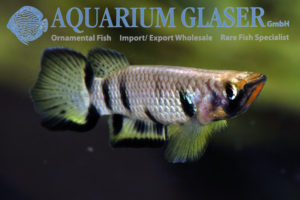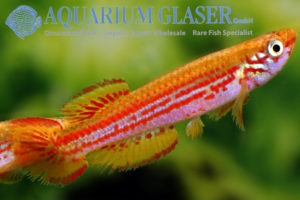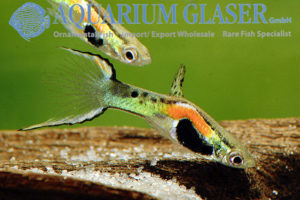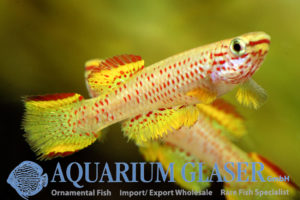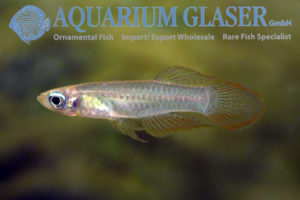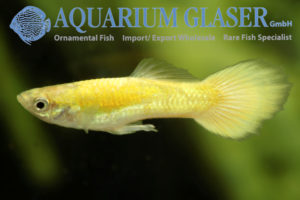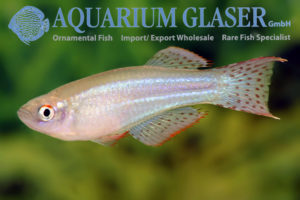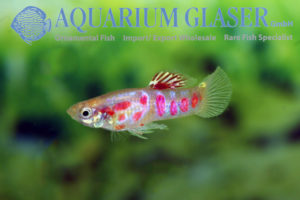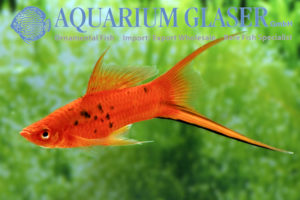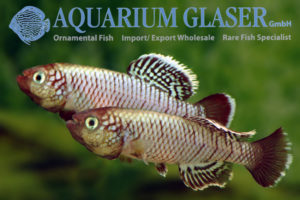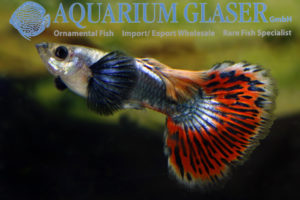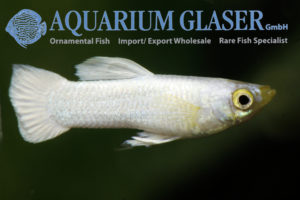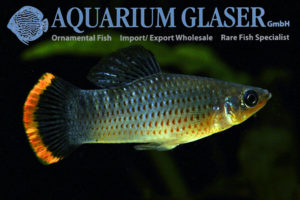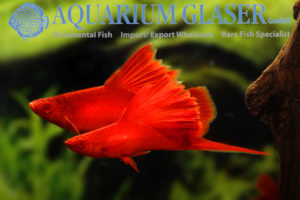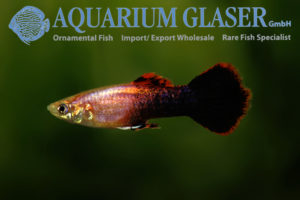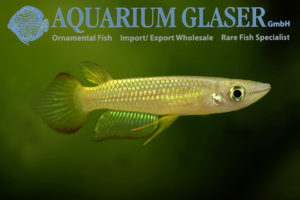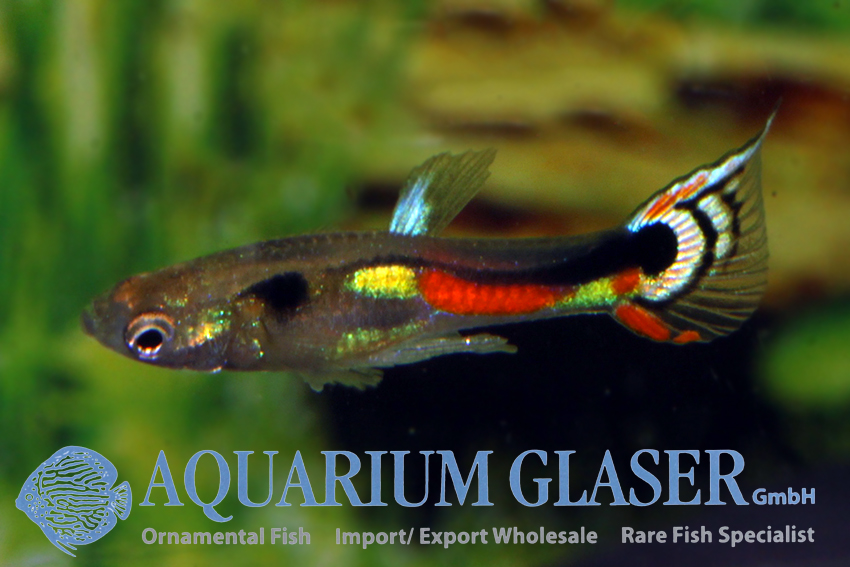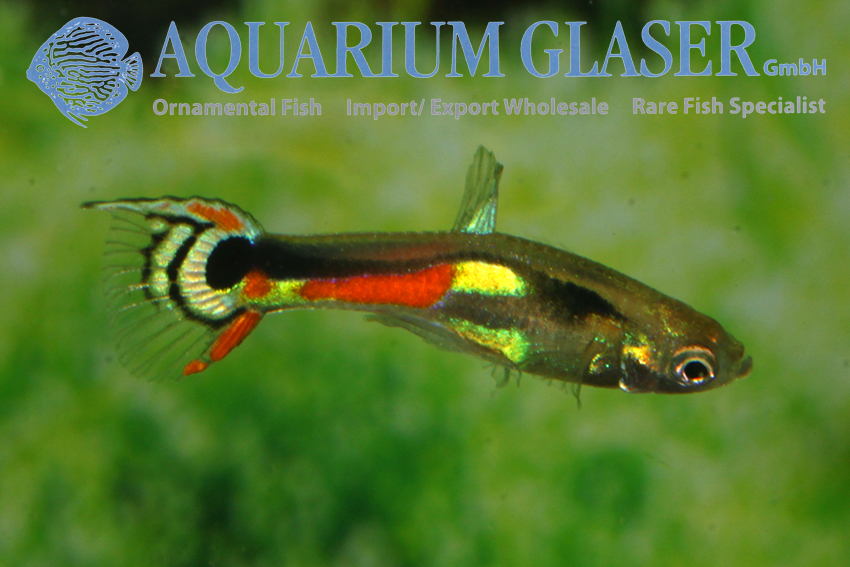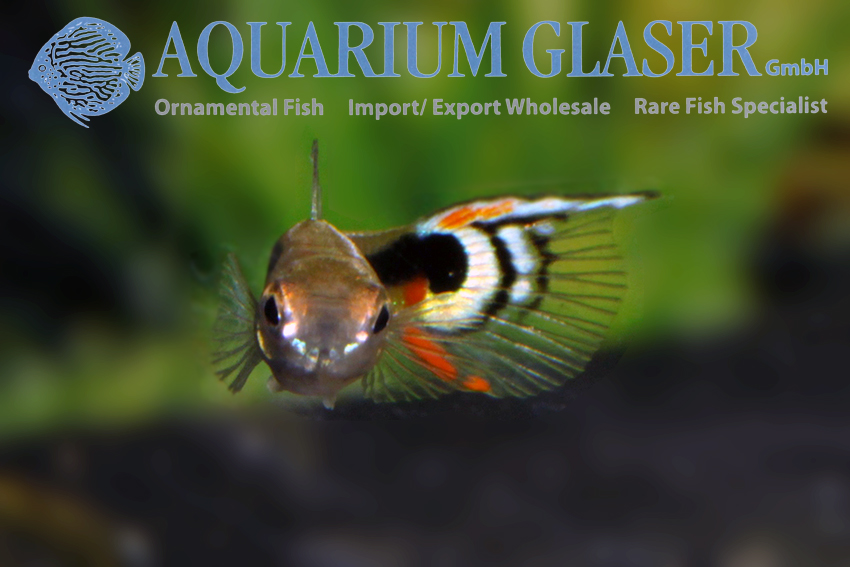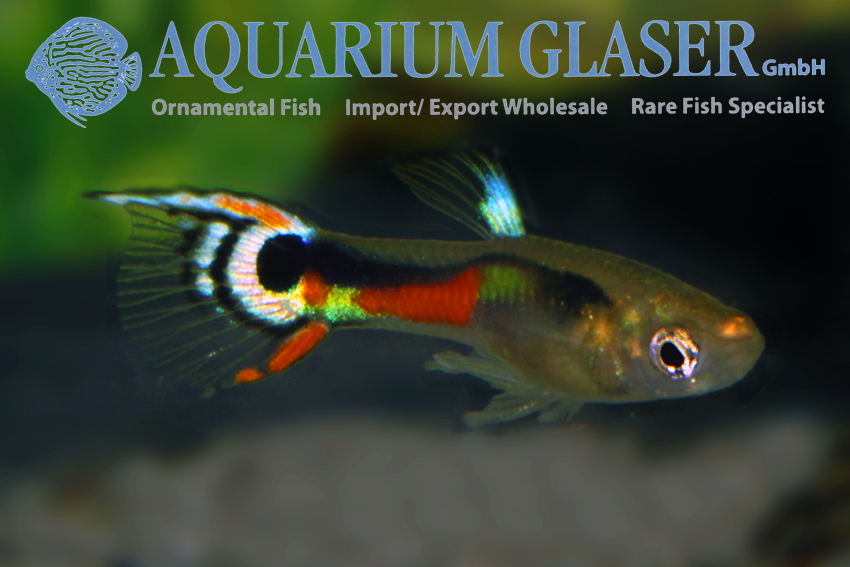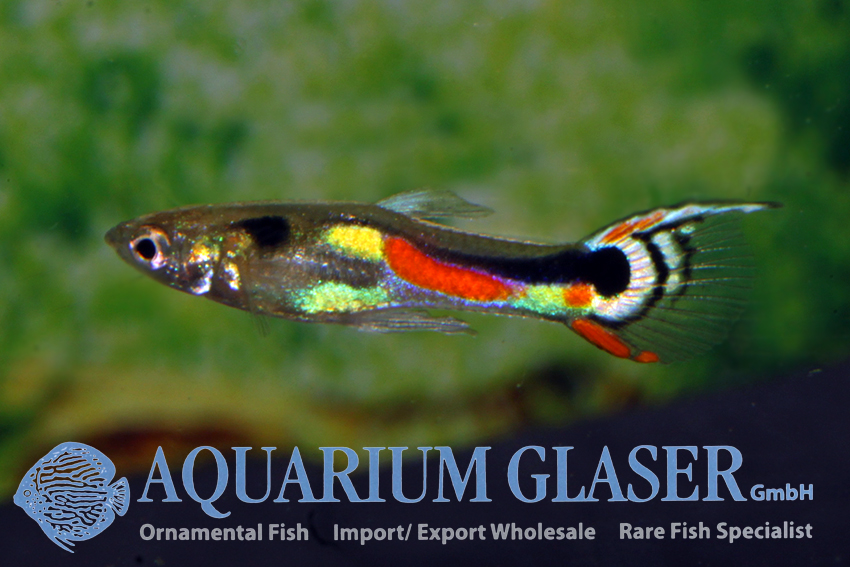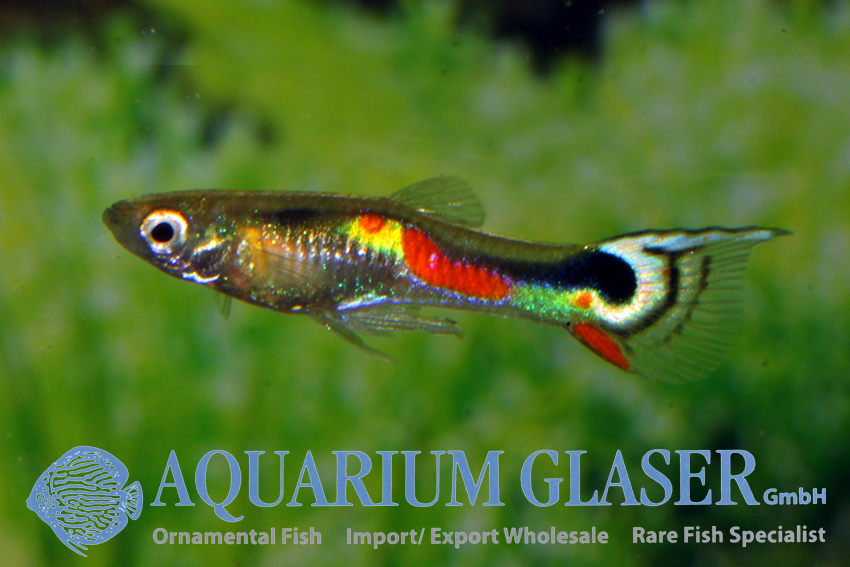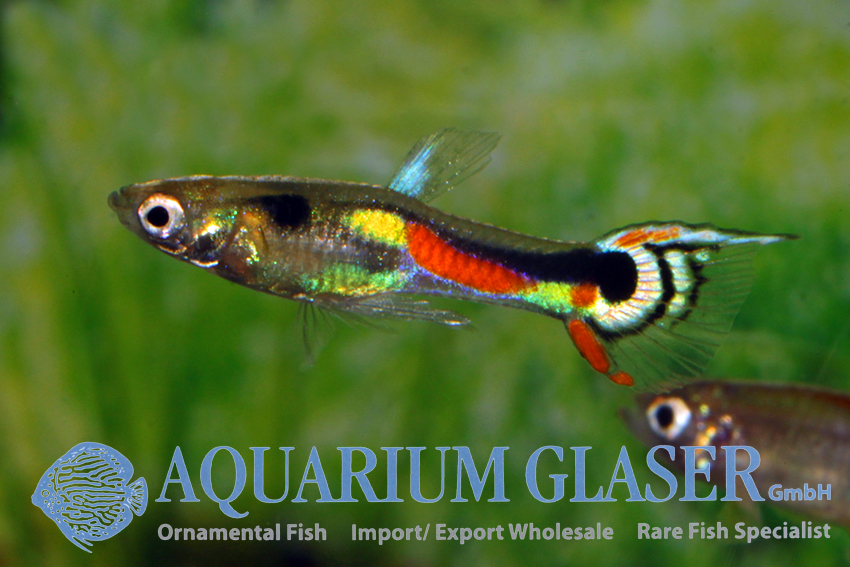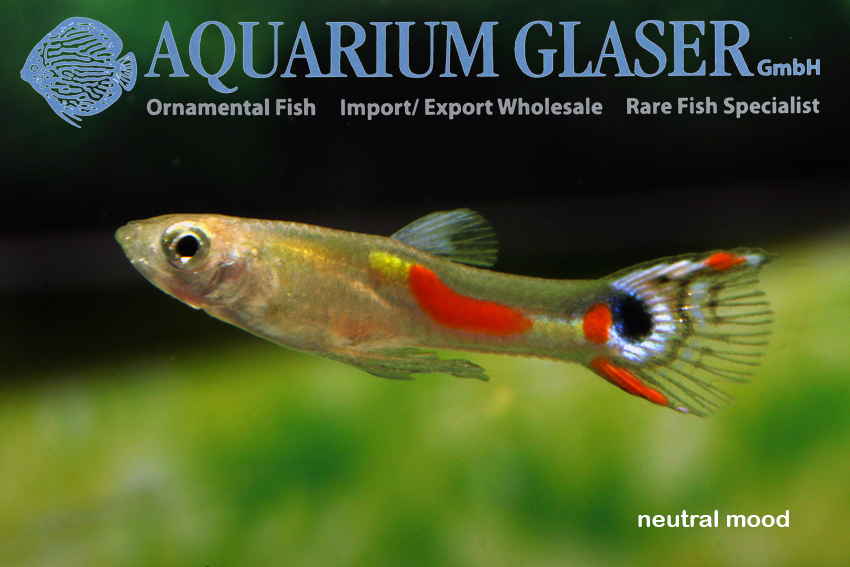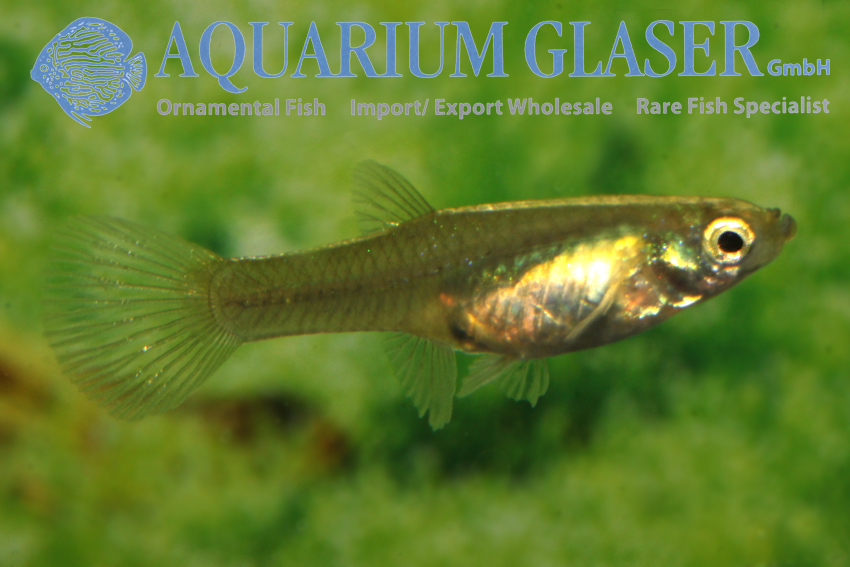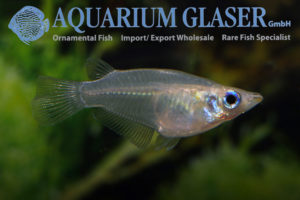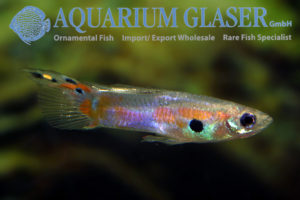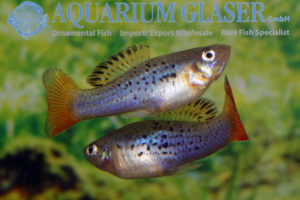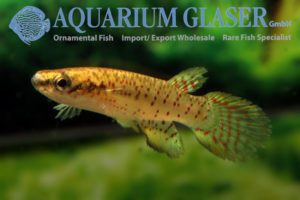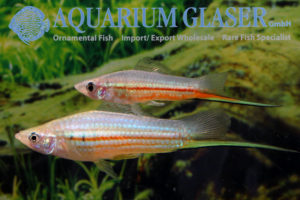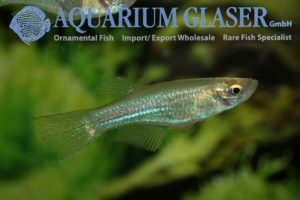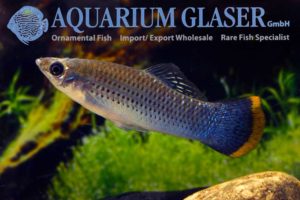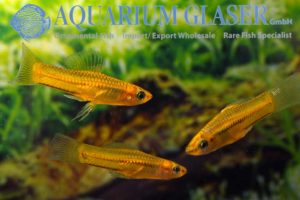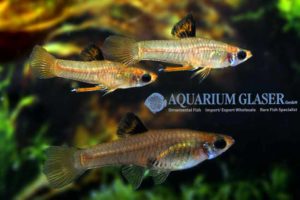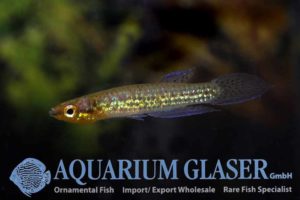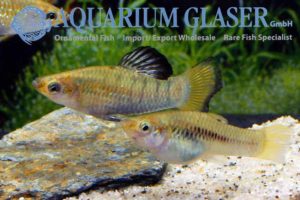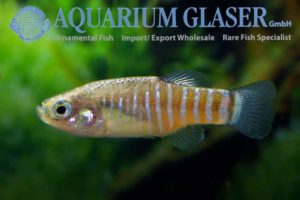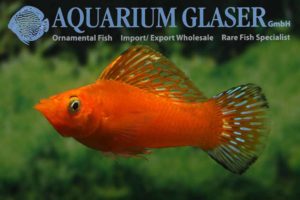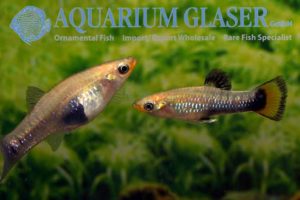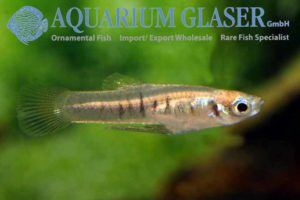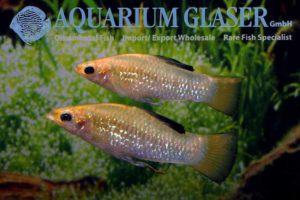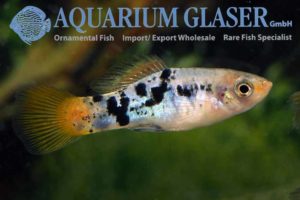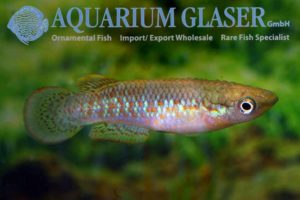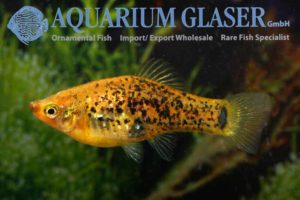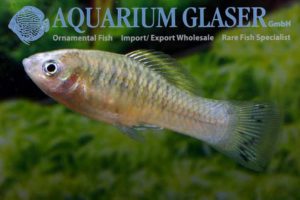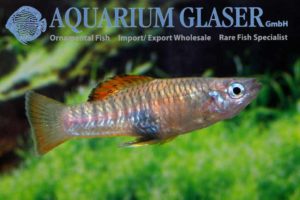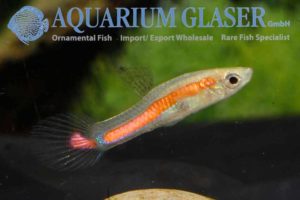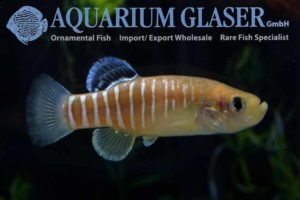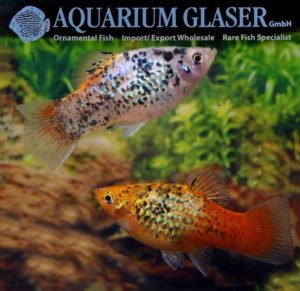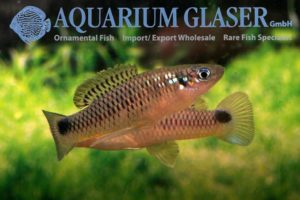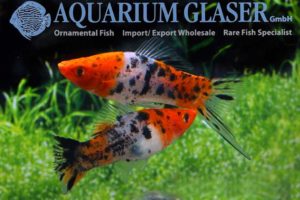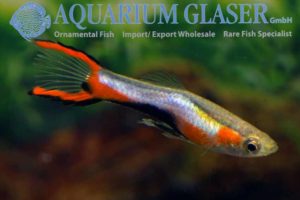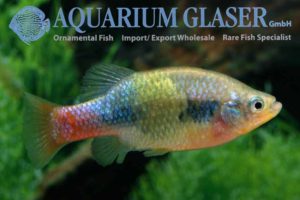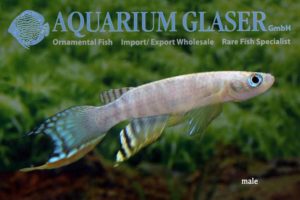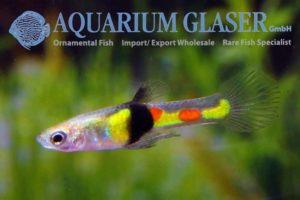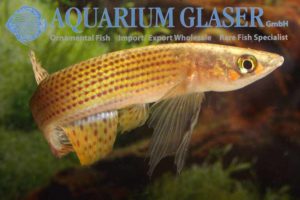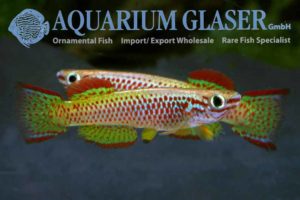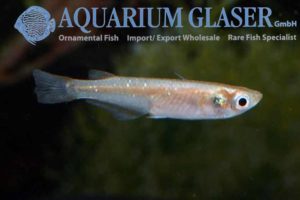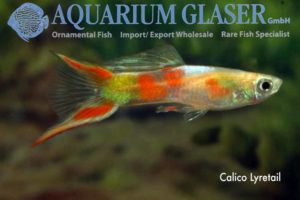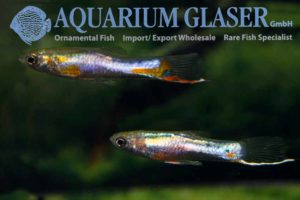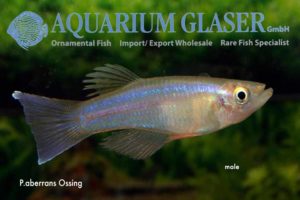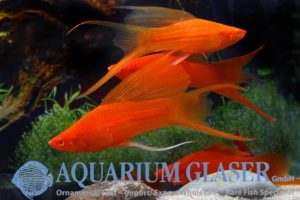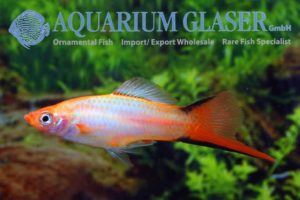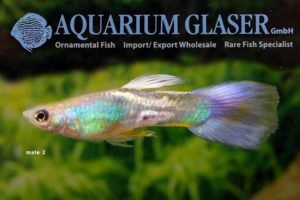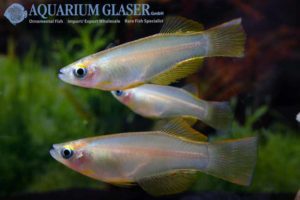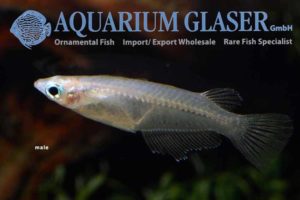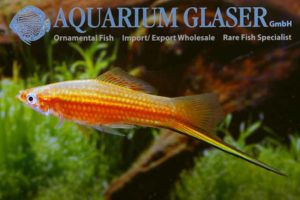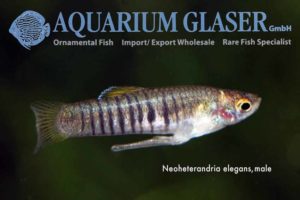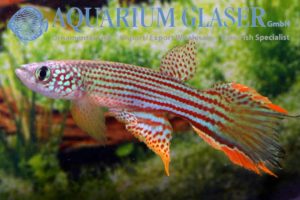Gambuses don’t have a good reputation in aquaristics. They are considered grey, quarrelsome and difficult fish. This is not completely wrong, especially when it comes to the worldwide plague Gambusia holbrooki. But few aquarists realize that there are 45 different species of Gambusia and it is very unfair to use the same comb for all […]
18. Toothcarps: Killis and Livebearers (300)
-
-
Xiphophorus maculatus “Belize Purple”
The wild type of the “normal” Platys (Xiphophorus maculatus) is cared for as good as never in the aquarium. This is partly due to the fact that “the” wild type of the Platy does not exist at all, but a large number of colour variants, which partly only occur locally, but partly also in different […]
-
Cyprinodon variegatus
The pupfish of the genus Cyprinodon live, so to speak, in the limbo for fish. Once the area, which today represents the desert regions of the western USA and northern Mexico, was a huge lake plate, the fish there lived in paradise. But the lakes gradually dried up over the millennia. Today, some species of […]
-
Flexipenis vittatus
Once more we are able to offer a beautiful dwarf livebearer that proofed to be a bit problematical in respect of breeding – not keeping! – in a long time sight under traditional aquarium conditions. However, under the open skies of Southeast Asia they breed pretty well. Flexipenis vittatus is also often placed in Gambusia. […]
-
Fundulopanchax spoorenbergi
Only extremely rarely, this pretty, maximum 7 cm long killifish is offered in the trade. Formerly, Fundulopanchax spoorenbergi was placed in the genus Aphyosemion. The species appears from Nigeria to Cameroon. No fear of short-lived Killifishes: this species is approximately as long-lived as other popular aquarium-fish, like Guppys or Platys. It should be noted that […]
-
Endler Guppy “Blue Tiger”
There are two different ways of breeding new Endler or Dwarf Guppies. One is to cross different color varieties of the pure species Poecilia wingei (Endlerguppy) with each other or to select and intensify certain color characteristics, which occur within a population, by selective breeding. The other way is to cross Endlerguppy and “normal” Guppy […]
-
Oryzias woworae XXL
The neon rice fish was the absolute sensation during its aquaristic discovery in 2010. At that time two neon rice fish were known: the “real” O. woworae from the small island of Muna and an O. cf. woworae from the main island Sulawesi. The most important optical difference between the two was seen in the […]
-
Nothobranchius palmqvisti
Yes, this pretty magnificent killifish actually writes itself “palmqvisti” and not, as one would think, “palmquisti”; this spelling with “v” was used in the first scientific description in 1907 and may not be changed. Palmqvists Nothobranch is an old acquaintance in the hobby and was first imported in 1958 and soon also bred with good […]
-
Poecilia (Limia) tridens
There is no agreement on the systematic position of the livebearers living on the Caribbean islands. According to anatomical characteristics, the genus Limia is today mostly regarded as synonymous with Poecilia, but they have so many independent characteristics that Limia is almost always mentioned as a subgenus. Aquaristically this is not so important whether Limia […]
-
Guppy Endler Cross “Santa Maria Bleeding Heart”
Since 2015 we know this very attractive Guppy, which is a cross of the species Poecilia reticulata and P. wingei and which is attributed to the Japanese breeder Kenichiro Tamura. From the common Guppy, this fish has inherited the more robust shape, especially of the females, and the less intense courtship behaviour, while the petiteness […]
-
Chromaphyosemion bitaeniatum LAGOS
This beautiful killi is only very occasionally available as German bred. Currently we have some of these bred ones in stock. They are descendants from the population from Lagos (Nigeria). Our fish are large, full in colour and very pretty. This species is suitable for community tanks with peaceful, small fish (barbs, tetras, catfish etc.). […]
-
Black Molly = Black Molly?
Sometimes we also take a closer look at the everyday species; one tends to judge fish like the Black Molly in trade only according to the aspects: 1. are the fish healthy and stable? and 2. are they well grown? But Black Molly is certainly not the same as Black Molly. Depending on which wild […]
-
Oryzias latipes – Medaka breeding forms
The care and breeding of the Japanese Rice Fish or Medaka has a very long tradition in Japan. Already around 1900 gold-colored Medakas were mentioned in the aquaristic literature. The breeding of these small fish is currently experiencing a renaissance in Japan. Friedrich Bitter drew attention to this and also imported many of these forms […]
-
Xiphophorus andersi
Once again we can present and offer you a top rarity among the wild forms of livebearers: Xiphophorus andersi. Most likely the animals we have received from a German breeder are the first ever to be offered in the ornamental fish wholesale trade. Xiphophorus andersi comes from the Rio Atoyak in the state of Veracruz, […]
-
Aplocheilichthys luxophthalmus (= Poropanchax luxophthalmus)
Currently we were able to import once more one of the most beautiful lampeyes from Nigeria: Aplocheilichthys luxophthalmus. Those who follow the splitting of the genus Aplocheilichthys place the maximum 3 cm long fish in the genus Poropanchax. A. luxophthalmus is a schooling fish that should never be kept in groups with less than ten […]
-
New highly selected guppys: Koi Red Tuxedo Red Nose and Full Black
In this case “new” does not mean that there were no colour varieties like this before, but that we have a new breeder, who gives us these and other high end breeding guppies in pairs and colour hits, so that we can pass on really fantastic animals. Of course there is also a certain variance […]
-
Pachypanchax sakaramyi – one of the rarest fish in the world
Although the species Pachypanchax sakaramyi – it originates from the Sakaramy River on Madagascar – was described as early as 1928, it could not be found for decades afterwards and even was referred to the realm of legends. It was not until the 1990s that they were found again. From these animals (5 pairs), which […]
-
Priapella compressa
The Blue-eyes from Mexico are closely related to the Knife-bellies (Alfaro). Like these, the males of Priapella have a massive keel along the underside of the tail. All Priapella attract attention by their blue, shining eyes. They are powerful swimmers who appreciate a good current. In nature they live close to the surface in clear […]
-
Xiphophorus variatus “Puente Escalanar”
Once again we can offer a extremely beautiful wild strain of the variatus platy in good numbers as German offspring. The ancestors of these animals were collected in 2002 in Puente Escalanar, Veracruz, Mexico by private hobbyists and brought along. Since then, the animals have enthused mainly the community of friends of livebearers; to our […]
-
Xiphophorus hellerii „Hamburg Highfin“
Only very rarely one of the most beautiful breeding forms of the swordtail comes to us: the black Simpson with orange fins. Among fish lovers Bayreuth is known as the spade for this very distinctive swordtail breeding form and is called “Bayreuth Cross”. In Germany, this variant was first exhibited in 1968 (report by the […]
-
Guppy “Red Smoke”
Glasbelly guppies do not produce guanine due to a genetic peculiarity – this is the silver dye that makes fish glisten. This makes them more or less transparent, as the guanine normally reflects the light and prevents transparency like a mirror. Mostly Glasbelly guppies are bred as albinos. If the black melanin also falls away, […]
-
Poecilia caucana
With an overall length of 3 – 5 cm the Cauca Molly (Poecilia caucana), originating from Colombia, Venezuela, and Panama belongs to the smaller livebearers. Remarkably is the yellow – orange coloured dorsal fin and a violet metallically shining along the body as well as the orange band in the proximal part of the caudal […]
-
Micropoecilia picta Red
This extremely beautiful livebearer has been discovered in 1991 by Dieter Bork in eastern Venezuela near Tucupita. Here it inhabits the floodplains of the Orinoco river. Bork was able to collect and export some specimens. Micropoecilia picta is very variable in respect of coloration. However, in contrast to M. parae, usually only one colour variety […]
-
Xiphophorus hellerii „Kohaku“
Red-white, koicoloured livebeares are very hip currently. Usually the commercial breeders do not name their creations by their genetic compostion – like private hobbyists do -, but name them instead with as fancy names as possible. The „Kohaku“ is a white albino swordtail with a bright red patch on the front part of the body. […]
-
Guppy Endler Red Chest Saddleback
A few years ago we were able to import for the first time guppys that exhibited a black saddle bar over the back, starting at the base of the dorsal fin. These fish were called Yellow Half Tuxedo (see https://www.aquariumglaser.de/en/fish-archives/brandnew_guppy_endler_yellow_half_tuxedo_en/). An advancement of these guppys represents the Red Chest Saddleback. The breeder takes care that […]
-
Xiphophorus maculatus Platy Coral Kohaku
White-red sports in Xiphophorus are pretty demanding for the breeder. Interestingly these fish are all usually born in a crystal red coloration. Only after a few weeks the red breaks up and white patches become visible. Some of the fish become totally white when fully grown, others totally red, but most of them show red […]
-
High End Guppys
Currently we can offer several High Quality German Bred Guppys. This breeder is specialized inbreeding rare varieties that are offered by pair, which means that the genetically correct female is supplied along with the male. The sports illustrated here – „Full Platinum Albino“ and „Yellow Tuxedo“ – are only two of serveral ones we have […]
-
Poecilia reticulata Guppy Yellow Taxi Glass Belly
These Glass Belly Guppys are very special. Their coloration lacks not only all black pigment – they are true albinos – but also the silver pigmentation of the abdomen. So one can study the complete develepment of the eggs and youngsters in the belly of the female fish. This means these fish are a perfect […]
-
Molly Copper Lyretail
A beautiful sport of Molly from Singapore is Copper Lyretail, a very colourful variety. Obviously the species Poecilia sphenops formed the basis of that strain. The combination of the colour copper and the lyretail led to males in which the anal fin is much too broad to serve as a gonopodium. So the pure males […]
-
Phallichthys tico
Once more we are able to offer this top-rarity among the livebearers. The charming fish – males reach a maximum length of about 2.5 cm, females 4.5 cm – are restricted to the upper reaches of the river San Juan in Costa Rica and Nicaragua. No commercial fishing for ornamental fish does exist there and […]
-
Epiplatys dageti monroviae
This panchax belongs without any doubt to the most popular killifish at all. There are many reasons for that: the beautiful coloration, the small size (4-5.5 cm), the fact that these fish can be kept in community tanks, and the adaptility to many different water conditions are some of them. The Red Chinned Panchax is […]
-
Aphyosemion punctatum
This gorgeous killi originates from Gabon. We can currently offer very nice German bred ones. The beautiful red and yellow colours fit perfect in the x-mas time, don´t they? Keeping and breeding the up to 4.5 cm long species can be compared with the by far better known lyretail killi, Aphyosemion australe. For our customers: […]
-
Guppy Endler Black Bar
There are so many new sports in Endler guppys (Poecilia wingei); it is really difficult to keep the overview. Sadly some of these new sports loose the charme of the wild type fish which are characterized by the very tiny males (usually they should not grow larger than 1.5 – 2cm) and the overboarding vivacity. […]
-
Aphyosemion gabunense marginatum
The concept of subspecies is denied by many recent ichthyologists. They argument that there are either differences – in that case the fish are full species – or there are no differences – in that case they don´t have to be named at all. However, this argumentation does not consider the existing fact that both […]
-
Aplocheilichthys normani
A real classic among the species of fish that Takashi Amano preferred to use for his legendary nature aquaria setups is Aplocheilichthys normani (= Poropanchax normani). A single specimen of that lampeye is a rather drab creature, but a larger school of them in a tank with dimmed light is like magic! The blue eyes […]
-
Guppy Platinum Gold
The latest creation from the jewellery Sri Lanka: Platinum Gold. This fish is a further development of the Guppy Full Platinum, which we obtained in August, also from Sri Lanka. The yellow or golden coloration differs a lot individually in the Platinum Gold. Some specimens look like the Full Platinum, just with a yellowish tinge, […]
-
Procatopus aberrans
We obtained very nice Procatopus aberrans from Nigeria. These lampeyes are very peaceful schooling fish that live near the water surface or at least in the upper third of the water column. In contrast to most other species of lampeye that have an iridescent blue zone in the iris, in P. aberrans the iridescent zone […]
-
Guppy Endler „Ginga Rubra“
This charming sport of the Guppy is said to have been developed in Japan. The name of the Japanese breeder is cited as Tanaka. The „Ginga Rubra“ is a very lively and robust sport. Our specimens are German bred ones, the basic colour of our fish is blond. For our customers: the fish have code […]
-
Xiphophorus hellerii King Lyratail
Lyretail swordtails are a sport of Xiphophorus hellerii and rather difficult to breed. Usually only the females can be used for breeding. They need „normal“ males for mating, because in most Lyretail males the fin that is used for insemination in livebearers, the so called gonopodium, is much prolonged and useless. Among ornamental fish breeders […]
-
Nothobranchius eggersi Kubiti-Utete 07
Among the most variable species of kiliifish is Nothobranchius eggersi, the Orchid nothobranch. This species has been discovered on an expedition in winter 1980/81 by Lothar Seegers, Gerd Eggers, and Christel Kasselmann in eastern Tanzania. One year later L. Seegers described the species scientifically. The species lives endemic in the Rufiji river basin. The type […]
-
New Guppy: Elephant Ear
The pectoral fins in Guppys are usually transparent. But there do exist sports with black pectoral fins, like the so called „nigrocaudatus“-types and the Moskow Guppys. Breeders have made this peculiarity the target of their most recent new sport. Obviously initially only colourful guppys with pitchblack pectorals were planned, but then the breeders discovered that […]
-
Guppy Full Platinum
My dear! After 15 years of pleasureful co-operation our flashlight installation of the photo tank crashed. Today the substitute arrived and we tested it with the latest guppy sport from Sri Lanka: Full Platinum. As anybody knows who has ever tried it: totally white and totally black fish are the hardest challenge in respect of […]
-
Poecila mexicana Campeche
The wild mollys from Central America were always and will stay an enigma for generations of scientists. In each brook the fish look somewhat different. And as if that would not be eough, they also have within every population different shaped males: small and slender early ripe male, large and deep bodies late ripe males […]
-
Xiphophorus hellerii „Broccoli“
What is a Broccoli swordtail? A green swordtail that smells like cabbage? No, not at all! If one crosses a simpson swordtail – simpsons are the swordtails with the long dorsal fin – with a lyretail swordtail – lyretails have prolongations in all fins – some of the offspring have a very long simpson dorsal […]
-
Guppy Magenta Tuxedo
The breeders and farmers of ornamental fish in Sri Lanka still suffer from the catastrophal rains some weeks ago. Nevertheless they supply us with wonderful guppys and other livebearers, for example the beautiful Guppy Magenta Tuxedo. We have this strain from Sri Lank since 1998 in stock. All customers that order now bred fish from […]
-
Aplocheilus lineatus “Gold”
The golden sport of Aplocheilus lineatus is very popualr in the aquarium hobby and the only member of the genus that can be found on a regular basis in the petshops. The reason for that is quite simple: the golden sport exhibits even as a small juvenile (3-5 cm length) already the attractive coloration, while […]
-
Oryzias dancena “Thailand”
Usually we obtain the rice fish (Oryzias dancena, in elder books often referred to as O. melastigma) from India. This is also the country from where it as been described scientifically. But now we obtained very healthy and vivid specimens from Thailand. Oryzias dancena can be distinguished from other, similar species quite good by the […]
-
The story of the Cologne wild guppy
It was back in 1977 when first reports about this „German wild guppy“ appeared in aquarium journals. This was in the „Informationen der Deutschen Guppy-Förderation Nr.3“. Shortly after that Franz-Peter Müllenholz wrote a report for the magazine TI (No 42, June 1978) on that fish that lived in a brook near Cologne. The water was […]
-
Xiphophorus variatus „La Laguna“
Once more we can offer a very beautiful wild sport of the variable platy: La Laguna! Our specimens are German bred. This sport originates from San Luis Potosi in Mexico; La Laguna de la Media Luna is a very popular place for tourism. The peculiar difference of the population La Laguna to other sports of […]
-
Rivulus punctatus
This charming dwarf killi – it becomes only 3-4 cm long – reached us from Paraguay. The species is remarkable for several reasons. First of all this is the species of Rivulus that can be found most far in the south. R. punctatus can tolerate temperatures as low as 12°C for a short time. These […]
-
Xiphophorus hellerii „guentheri Golden Stream“
Once more we can present to you an interesting and beautiful wild variety of a livebearer: Xiphophorus hellerii „guentheri Golden Stream“, This unusual Green Swordtail originates from the surroundings of the Golden Stream preserve in Belize, Mexico. This presevere covers an area of about 61 km2 and contains a large number of rare and endangered […]
-
Procatopus aberrans
We obtained very nice glitter fishes from Nigeria: Procatopus aberrans. These lampeyes are very peaceful schooling fish that live near the water surface or at least in the upper third of the water column. In contrast to most other species of lampeye that have an iridescent blue zone in the iris, in P. aberrans the […]
-
Poecilia mexicana CAMPECHE
The wild mollys from Central America were always and will stay an enigma for generations of scientists. In each brook the fish look somewhat different. And as if that would not be eough, they also have within every population different shaped males: small and slender early ripe male, large and deep bodies late ripe males […]
-
Xiphophorus pygmaeus
Males of the Pygmy Swordtail (Xiphophorus pygmaeus) become only about 3.5 cm long. So they bear an objectively correct name. The females become a bit larger, but even the dames are very small fshes, compared with the commonly known Swordtail, Xiphophorus hellerii. A very nice, yellow sport of the Pygmy Swordtail exists. It is also […]
-
Xenophallus umbratilis
Sadly this very attractive livebearer can be offered only very rarely. The species is also known as the “Golden Teddy” among hobbyists. Males become about 4 cm, females up to 6 cm long. Initially the species is native in Costa Rica, but the fish we have in stock now are German bred ones. For our […]
-
Aphyoplatys duboisi
It has been many, many years ago since we were able to import this charming dwarf killi the last time. Currently the fish are about 1.5-2 cm long, maximum length reported for Aphyoplatys duboisi is only 2.5 cm. The fish have been collected in the surroundings of Brazzaville. Despite their very small size these fish […]
-
Limia Special
Poecilia (Limia) perugiae The Dominican Republic is the destination for millions of tourists each year. But it is only known by few people that also beautiful freshwater fish exist there. One of the prettiest of them is Poecilia perugiae. We can offer this beautiful livebearer on a quite regular basis, but have usually only few […]
-
Aphanius farsicus
Currently we have some fish in stock that are available every year only for a few weeks. These species are kept and bred by the hobbyists in a very special way, the “balcony aquarium hobby”. The species kept in that manner are specialized in water temperatures that differ clearly between day and night and they […]
-
Poecilia velifera NEON ORANGE
We received this new sport of Molly from Southeast Asia. It was offered under the name of “Neon Orange”. The special feature of the new sport is the reflecting border of the scales on the back in front of the dorsal fin. This is more obvious in females than in males. In males. the reflecting […]
-
Poecilia (Limia) melanogaster
It happens only rarely that a wild form of livebearer is kept continuously over decades by hobbyists. This is understandable if one takes a look on the immense number of colourful sports that do exist from guppy, platy, molly & co.. So, if a wild form is able to compete with them it is without […]
-
Scolichthys iota
For the first time ever we are able to offer this tiny species of livebearer. Scolichthys iota has been discovered and described back in 1967 already, but has become never known alive to hobbyists until very recently. Our specimens are German bred. Males attain a maximum length of only 1.5 cm, females get almost double […]
-
Poecilia (Limia) perugiae
The Dominican Republic is the destination for millions of tourists each year. But it is only known by few people that also beautiful freshwater fish exist there. One of the prettiest of them is Poecilia perugiae. We can offer this beautiful livebearer on a quite regular basis, but have usually only few specimens in stock. […]
-
Xiphophorus variatus Rio Nautla
We obtained in very limited numbers this beautiful local variety of the wild variatus platy (Xiphophorus variatus) from a German breeder. The Rio Nautla variety is a fish that occurs in the wild, not an artificial sport! For our customers: the fish have code 442983 on our stocklist. Please note that we exclusively supply the […]
-
Pachypanchax playfairii
Aquarists who like to read in elder books find this killifish in all literature until the 1970ies: the Golden Panchax, Pachypanchax playfairii. Then the species seems to have disappeared from the aquarium hobby mainstream. By the way: the Golden Panchax is the only primary freshwater fish species from the Seychelles. The Golden Panchax belongs to […]
-
Xiphophorus milleri
This is another, very interesting species of wild livebearer we can offer. Our specimens are German bred. Initially this platy oroginates from the Laguna Catemaco, a freshwater lake in Mexico. X, milleri lives exclusively in this lake, it is an endemic species. The lake has a volcanic origin. Depite the fact that the water temperature […]
-
Xiphophorus variatus Rio Pantepec
For the first time ever we can offer this very interesting wild form of the variable platy in small numbers. The original stock of this variety has been collected in the Rio Pantepec in Mexico (state of Veracruz). The pattern differs a lot individually – a typical feature of Xiphophorus variatus – but the vertical […]
-
Brachyrhaphis roseni
Generally speaking, wild forms of livebearers are only rarely seen in the hobby. However, aquarists who specialize themselves in these fishes are most often that fascinated that they never give them up anymore. One of the most beautiful species is Brachyrhaphis roseni, which originates from brooks running through woodland in Panama and Costa Rica. Keeping […]
-
Wild Guppy Rio Morichal
The wild guppy from the Rio Morichal in Venezuela is also known as “orange line” among the specialists for wild forms of livebearers. These fish are a very tiny and slender variety of wild guppy, but not an artificial sport. In contrast to other wild populations of the guppy this one is known to be […]
-
Aphanius vladykovi BOLDAJI
Members of the killifish-genus Aphanius appear only in Europe, North Africa, and Asia. In the aquarium hobby they are really rarely seen, and can be hardly ever found in a regular pet shop. Sadly many of the currently 22 accepted species and subspecies are in danger of extinction due to habitat destruction. This is a […]
-
Platy Pepper & Salt Rainbow
We start in the new week with an extremely pretty salt & pepper sport of the platy. Each individual has a somewhat different colour. Some are rather red, other rather blue, most are a mix: rainbows! This new sport is a real and beautiful enrichment of the assortment! For our customers: the fish have code […]
-
Pseudoxiphophorus anzuetoi
We can offer for the first time ever a very unusual livebearer: Pseudoxiphophorus anzuetoi. Possibly the specimens we currently have in stock are even the first ones traded ever worldwide. This species has been placed formerly (like all other species of Pseudoxiphophorus) in the genus Heterandria due to anatomical reasons. Funny enough, this led to […]
-
Xiphophorus hellerii KOHAKU TRICOLOR
Swordtails with three different colours are know at least for 15 years now. But breeding them is really tricky, because only few of the offspring has a nice pattern. Especially the black parts can cause problems. Specimens with a high dregree of black tend to have cancer (melanomia) and this ends as often fatal as […]
-
Endler Guppy Sky Blue
The new sports of the Endler Guppy are fantastic fishes. The brandnew sport “Sky Blue” which we obtained now for the very first time, is a perfect example. It is not only the brilliant coloration that makes these fishes so desirable, but also the lively behaviour. When the males do their harmless display-fights no real […]
-
Xenotoca eiseni San Marcos
Only once per year we obtain a number of very rarely offered Goodeids, bred by a specialized breeder. This year the shipment contained inter alia the probably most beautiful species of these interesting livebearers: the San-Marcos-population of Xenotoca eiseni. For our customers: the animals have code 476513 on our stocklist. Please note that we exclusively […]
-
Aphyolebias peruensis
Aphyolebias peruensis Once more we were able to import this beautiful killifsih from Peru. The pictures show animals from our current stock. For more informations, please see http://www.aquariumglaser.de/en/news/Aphyolebias_peruensis_en/ For our customers: the fish have code 342803 on our stocklist. Please note that we exclusively supply the wholesale trade. Text & photos: Frank Schäfer
-
Endler´s Guppy El Tigre
One of our breeders in Thailand loves wild forms of small livebearers. He now was able to send us for the first time ever the “El Tigre” variety of Endler´s Guppy (Poecilia wingei). The fish represent a pure strain of a population that was initially collected in El Tigre, Venezuela. Of course the fish are […]
-
Moema hellneri (= M. cf. ortegai)
We were able to import astonishing large Moema hellneri (formerly: Moema cf. ortegai, see comment below) from Peru. The females are around 8 cm, the males around 12 cm long. This places them among the largest species of killifish known so far. The extremely large pectoral fins of the males are very impressive. However, the […]
-
Aphyosemion gabunense
We obtained beautiful German bred specimens of this really nice killifish. A. gabunense is the perfect species for all aquarists who like the colorful killifish group but did so far not dare to keep them: A. gabunense is a really hardy fish and pretty easy to keep. The Gabon killi attains a maximum length of […]
-
Oryzias latipes
The Japanese Ricefish or Medaka is the typical pet of the Japanese scientists that work on genetics. Uncountable numbers of scientific papers exist about this fish. Nevertheless the wild type of Medaka is a top rarity in the ornamental fish trade. We now managed to obtain for the first time ever a wild type of […]
-
Double Sword Guppys
What would the hobby be without guppys? Probably anyone who keeps ornamental fish has kept and bred at least once a guppy. The lively fish that shimmer in all colours of the rainbow are for sure among the most popular ornamental fish species at all. There are countless sports and even – genetically speaking – […]
-
Poecilia wingei Blue Star
Poecilia wingei is also known as the Endler´s Guppy, named after the most common local variety of that species in the hobby. It stays much smaller than the common guppy and this daintiness makes the fish very attractive for many aquarists. As in the common guppy a lot of local varieties can be observed in […]
-
Procatopus aberrans and P. nototaenia
One of the beautiful species of Procatopus which we were able to import from Cameroon, has already been introduced to you: P. similis from Mundemba (http://www.aquariumglaser.de/en/news/Procatopus_similis_MUNDEMBA_en/). Now two additional species follow: Procatopus aberrans from Ossing and P. nototaenia from Yabassi. The latter is sometimes considered to be an undescribed species by killifish specialists and then […]
-
Xiphophorus hellerii Wien Lyra
Even in wild living swordtails one can observe the tendency in females to mate only with the most impressive males. And so in swordtails the swordfin developed. This fin is obviously a pure luxury without any practical use, comparable best with the train in male peacocks. The only use of this is to impress the […]
-
Xiphophorus hellerii Pastel Comet
The blue eye tells us that this wonderful new sport of the swordtail has been developed on white-bodied ancestors. This makes the red color on the body look so magically crystalline. The blue shine all over the body is fascinating. Finally, the dynamic “Comet” pattern on the tail puts the finishing touches on the fish. […]
-
Guppy Blue Sapphire
Once more the breeders in Asia have developed a new, very nice guppy sport. The name “Blue Sapphire” is well chosen, for the fish shine in frontlight bright blue. Technically spoken, the “Blue Sapphire” is a sport of the Moskow strain of Guppy. One could name these little gems also “chameleon guppy”, for the males […]
-
Procatopus similis MUNDEMBA
Our current Cameroon import contains also several local varieties of the magnificent lampeyes of the genus Procatopus. We want to introduce them to you in the near future. We start with a variety of P. similis from Mundemba, which is a breathtaking yellow species. Even the upper border of the iris is golden-yellow in this […]
-
Oryzias dancena
The elder hobbyists will know this nice blue-eye from India under the name of O. melastigmus; but this is another species, which is hardly ever kept in aquaria. Our O. dancena originate from the area around Calcutta in India, where they live along with so popular fish species like the zebra fish (Danio rerio) and […]
-
Xiphophorus hellerii Yucatan
In 1975 the Berlin aquarist Günter Daul collected during a holiday trip in Mexico some swordtails in the state of Quintana Roo and brought them to his homeplace successfully. This strain was called later erronously Xiphophorus hellerii Yucatan. However, the state of Yucatan is located west of Quintana Roo. Thus the strain should be named […]
-
Heterandria formosa and Neoheterandria elegans
Dwarf livebearers Finally we are able to offer once more both species of dwarf livebearers. Both are German bred ones. Dwarf livebearers are the smallest species of livebearing fish that are commonly kept in aquaria. Males become only 2 cm, females 3 cm long. Heterandria formosa, also known as the “Least killifish” is the more […]
-
Moema sp. Venezuela = Renova oscari
Yesterday we informed you in our Extra-Newsletter about the arrival of a species of Moema from Venezuela, which was unknown to us so far. Some killifish-specialists informed us now that this fish represents a population of the monotypical (= containing only one species) genus Renova, which was described scientifically only in 1995. The genus Renova […]
Poecilia reticulata Guppy Kohaku / Koi
The red-white albino guppy is a very attractive fish. The females are quite uniform in respect of coloration. They all have a red head and a red caudal fin. In males things are different. Initially they are colored like the females, but fully grown males develop an individually different degree of red pattern on the body; so in large males all specimens look different.
For our customers: the fish have code 419203 on our stocklist. Please note that we exclusively supply the wholesale trade.
Text & photos: Frank Schäfer
Poecilia wingei, Endler´s Livebearer „White Peacock“
The breeding of the different sports of Endler´s Livebearer has become a popular branch of the hobby. There are a lot of sports, some artifical – developed by cross-breeding or selective breeding – some are different looking populations that appear in the wild. The White Peacock is such a wild type. The ancestors of the fish in the trade have been collected by Armado Pou in 2004 from the Laguna de los Patos North Lake, according to the informations available from specialized web pages. For sure the fish are now much more uniformly coloured than the animals living in the wild, but they still have their extremely lively habit and they have stayed so wonderful small and dainty. Displaying males become much darker in coloration, compared with the neutral coloration. We obtain our fish from our proofed breeder in Thailand. The matching females are also available.
For our customers: the animals have code 419117 on our stocklist. Please note that we exclusively supply the wholesale trade.
Text & photos: Frank Schäfer
New Guppy: Coral Tail

For the first time ever we have this new type of roundtailed Guppy in stock. It is bred in Sri Lanka. The basic body colour is silver-blue. In ideal specimens the tailfin is divided in three partes. The upper and lower part is black, the centre bright red.




For our customers: the fish have code 418363 on our stocklist. Please note that we exclusively supply the wholesale trade
Text & photos: Frank Schäfer
Endler´s Guppy, classic



In
the meantime Poecilia wingei is accepted as a species on its own by
most people working with guppys. However, the species itself is as
variable as the Common Guppy, Poecilia reticulata. This fact is often
overlooked. So the “classical” Endler´s Guppy represents already an
artifical sport that is based on selective breeding. The wild population
of the fish is much more variable in coloration. Nevertheless: the
classical Endler´s Guppy is one of the most beautiful and lively guppys
at all!


Currently we can offer very nice German bred ones.
For our customers: the fish have code 419063 on our stocklist. Please note that we exclusively supply the wholesale trade.
Text & photos: Frank Schäfer
New Endler Sports




Once
more we received new sports of the Endler Guppy from our proofed
breeder. “Green” is not only characterized by the green basic body
colour, but also by the white flagged dorsal fin. And in “Silverado” a
broad, silver-blue area over the posterior part of the body makes the
tiny fish look like small electric blue flashes under water!




For
our customers: the animals have code 419113 (Green) and 419114
(Silverado) on our stocklist. Please note that we exclusively supply the
wholesale trade.
Text & photos: Frank Schäfer
A beautiful swordtail: Xiphophorus hellerii PINEAPPLE

It
doesn´t have to be always rare wildcaughts. Many bred sports are also
very interesting animals to keep. They do not only look very nice, but
are also worth to be studied in detail by the experienced hobbyist.


The
coloration of the sport “Pineapple” of the swordtail (Xiphophorus
helleri) for example has been crossed in the species from the Platy
(Xiphophorus maculatus). In the wild the two species never cross, but
under aquarium conditions it is possible to cross them with some tricks.
The hybrids lok intermediate between the two parent species. But when
they are crossed back on one of the parent species it is possible to
obtain pure species agian, but with the colours of the other species.

For our customers: the animals have code 420362 on our stocklist. Please note that we exclusively supply the wholesale trade.
Text & photos: Frank Schäfer
Dwarf lampeyes (Fluviphylax) from Venezuela


The
miniature lampeyes belonging to the genus Fluviphylax become only 1.5
cm long and are very slender. The delicate animals are very sensitive,
so they are hardly ever imported. We are very proud that we were able to
manage an importation containing members of that genus from Venezuela.
And not enough with this: it also seems that our fish belong to a
species new for science! In all 5 species described scientifically so
far the anal fin has a higher number of rays. Also the light spots along
the lower belly that are present in our fish have not been described
yet for any other species of Fluviphylax. The species most similar to
our fish is F. obscurum.


So
hopefully our new imports will settle well and maybe they will even
breed. The sexes can be told apart rather easily (for people with good
eyes) by the shape of the ventral fins, which are pointed and prolonged
in males and rounded in females.


For our customers: the animals have code 325681 on our stocklist. Please note that we exclusively supply the wholesale trade.
Text & photos: Frank Schäfer
New Guppys!

Now
we can offer Guppys from a new breeder in Singapore. The breeder is a
German that migrated to Singapore. This breeder is specialized in
breeding rare varieties that are offered by pair, which means that the
genetically correct female is supplied along with the male.



Currently we have “Full Platinum Albino” and “Galaxy” in stock.






For
our customers: the fish have code 417097 (Full Platinum Albino) and
419100 (Galaxy) on our stocklist. Please note that we exclusively supply
the wholesale trade.
Text & photos: Frank Schäfer
New Nothos


The killifish of the genus Nothobranchius are wonderful seasonal species. This means that they live in their natural habitat only a few weeks during the rainy season. In the dry season the ponds vanish and the fish must die. But the eggs in the bottom survive for months or sometimes even for years until the next rain. With the falling rain new life awakens in the ponds and ditches of the African Steppe and the circle of life starts a new turn.


These fish are traded of course only as bred specimens. In aquaria they usually live one or two years. We have a new breeder now who supplies us with three additional types of these pretty fish, eg Nothobranchius foerschi, N. guentheri from Zanzibar and the blue sport of N. guentheri.


For our customers: the fish have code 331503 (N. foerschi), 332523 (N, guentheri Blue) and 332612 (N. guentheri Zanzibar) on our stocklist. Please note that we exclusively supply the wholesale trade.
Text & photos: Frank Schäfer
Small Neon Ricefish

For the first time ever we can offer now wild collected Neon Ricefish at a size of 1.5-2 cm. The charming fish are very lively and healthy. They belong to the species O. wolasi, which was known in the hobby as O. cf. woworae before its scientific description. The final size of the fish will be around 4 cm.
For our customers: the fish have code 340122 on our stocklist. Please note that we exclusively supply the wholesale trade.
Text & photos: Frank Schäfer





